Four-dimensional films
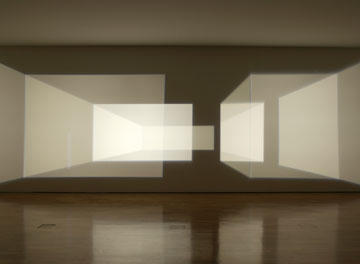



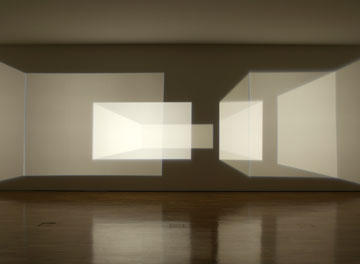
[Images: Space, sequence, light: architecture as a four-dimensional film you can walk through – taken from Reimagine (large version), 2002, by Olafur Eliasson].
Four-dimensional films     [Images: Space, sequence, light: architecture as a four-dimensional film you can walk through – taken from Reimagine (large version), 2002, by Olafur Eliasson]. Radio Aurora New York
"Powerful radio waves beamed up into the sky have created artificially enhanced auroras visible to the naked eye," New Scientist reports.
 [Image: Jan Curtis – loads of really exceptional photographs here (and that radio tower, above, is just a coincidence).] "Todd Pedersen from the Air Force Research Laboratory in Massachusetts and Elizabeth Gerken of Cornell University in Ithaca, New York, have created emissions of 'unprecedented brightness', using pulses of radio waves sent from a base station in Alaska. 'The beam is more like a flashlight than a laser,' says Pedersen. 'The total power is about the same as large shortwave transmitters like the BBC's.'" Now they just need to attach some radio transmitters to the tops of New York's tallest skyscrapers, and every night the city's skyline will be bathed in swirling auroras... Crackling wisps of a green and blue – and orange and red and yellow and white – ionized atmosphere will form snakelike rolling arcs and curtains between the mirrored outer walls of bank towers; ships at sea will see a city gone halo'd and prismatic. The international space station floats over an earth of urban auroras – London, Shanghai, Cairo... Auroras over the BLDGBLOG editorial offices... Indeed, auroras coming from the BLDGBLOG editorial offices... Urban fossil value
As Hurricane Rita carves away at the Gulf shore, Galveston burns, buses explode outside Houston, and New Orleans refloods through badly built and incompletely repaired levees, I stumbled upon an old article, from 1998, about fossilized cities.
Millions of years from now, in geographical regions "entombed by tectonic disturbances," entire cities – "the abandoned foundations, subways, roads and pipelines of our ever more extensive urban stratum" – will actually come to form "future trace fossils." These "future trace fossils," the article says, form easily preserved systems that are "a lot more robust than [fossils] of the dinosaurs. They include roads, houses and foundations." And yet, for all that, only those cities "that were rapidly buried by floods or sandstorms" will be "preserved for posterity." Los Angeles, for instance, "is on an upward trajectory, pushed by pressure from the adjacent San Andreas Fault system, and is doomed to be eroded away entirely." But if a city is flooded, buried in sand, or otherwise absorbed downward, "the stage is set to produce ideal pickling jars for cities. The urban strata of Amsterdam, New Orleans, Cairo and Venice could be buried wholesale – providing, that is, they can get over one more hurdle: the destructive power of the sea." It is often remarked in architectural circles how megalomaniacal Nazi architect Albert Speer came up with his so-called theory of ruin value, in which he proposed a new Romano-Fascist Berlin designed to look good as a ruin in thousands of years. But that's boring – let's talk about cities fossilizing over millions of years. Urban fossil value. The already buried, subterranean undersides of our Tube-hollowed, war-bunkered modern cities "will be hard to obliterate. They will be altered, to be sure, and it is fascinating to speculate about what will happen to our very own addition to nature's store of rocks and minerals, given a hundred million years, a little heat, some pressure (the weight of a kilometre or two of overlying sediment) and the catalytic, corrosive effect of the underground fluids in which all of these structures will be bathed." Who knew, for instance, that plastics, "which are made of long chains of subunits, might behave like some of the long-chain organic molecules in fossil plant twigs and branches, or the collagen in the fossilized skeletons of some marine invertebrates"? Who knew, in other words, that plastics will fossilize? 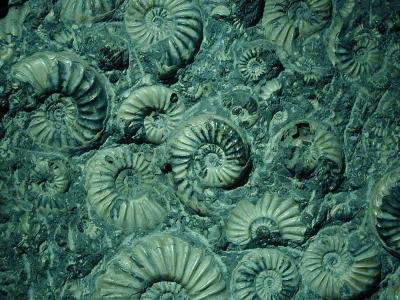 Indeed, "with a favourable concatenation of tectonics and sea level, our species could leave behind in a geological instant a much more striking record than the dinosaurs left in a hundred million years." 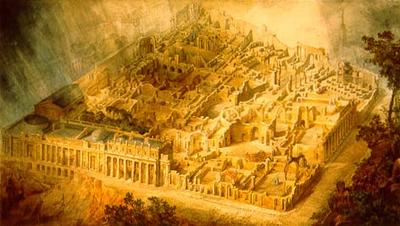 [Image: J.M. Gandy, speculations toward the ruins of John Soane's Bank of England – but, again, how about speculations toward the Bank of England's fossils...?] Space in Hong Kong
Michael Wolf's "Architecture of Density" – photos which reward close inspection – from a show at the Robert Koch Gallery:
      "[Michael] Wolf was born in Munich, Germany in 1954. He studied first at the North Toronto Collegiate Institute in Canada, then UC Berkeley and, in the mid 1970s, with Otto Steinert at the University of Essen, in Germany. Published monographs include Sitting in China (2002) and China im Wandel (China in Transition) (2001). Hong Kong: Front Door/Back Door will be published by Thames and Hudson in 2005." (Found through a link on Archidose; see also BLDGBLOG's recent posts on Sze Tsung Leong and Space in China.) Artificial diamonds and the snowflake chamber, pt. 2 Artificial diamonds, we read in Wired, can be "created in a chamber that mimics geologic conditions" – they are manufactured, in other words, inside surrogate earths. This chamber of geological mimicry is really "an 8,000-pound machine that use[s] hydraulics and electricity to focus increasing amounts of pressure and heat on the core of a sphere." Such hydraulic pressure recreates "conditions 100 miles below Earth's surface, where diamonds form. Put a sliver of diamond in the core, inject some carbon, and voilà, a larger diamond will grow around the sliver." All of this is done in a "30,000-square-foot factory, located in an industrial park outside Sarasota, Florida." Here, "a roomful of Russian-designed machines spit[s] out 3-carat roughs 24 hours a day, seven days a week." The warehouse is run by a company called Gemesis. Its owner jokes that, add another warehouse or two, and soon he'll have himself "a proper diamond mine."  [Image: two yellow diamonds by Gemesis. The diamonds are apparently undetectable as manmade except by the most expensive machinery De Beers can throw at them.] 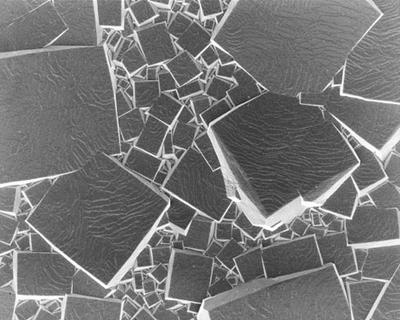 [Image: the inner crystallography of a diamond – looking almost as if "Black Square" by Kazimir Malevich hit the bottle and went to Kinko's with some time to kill:]  But Gemesis does not have the only – in fact, does not have the best – method for producing artificial diamonds. Apollo Diamond, based in Boston – in "a suburban strip mall occupied by a fitness gym and a graphic design company" – uses a process called chemical vapor deposition, or CVD. CVD "has been used for more than a decade to cover relatively large surfaces with microscopic diamond crystals. The technique transforms carbon into a plasma, which then precipitates onto a substrate as diamond." The diamond precipitates, forming "when a plasma cloud rains carbon onto diamond wafers" – but perhaps rain is not the appropriate analogy here. Using CVD, "diamonds could conceivably be grown in large bricks" – kicking off a whole new realm of architectural possibilities that the Wired article does not otherwise describe: a new diamond-walled Notre-Dame of constant refraction and transparent vaults, precision-cut into spires that would put Gaudí to shame. But it's the precipitation that interests me here, especially in the context of snow: "To grow single-crystal diamond using chemical vapor deposition, you must first divine the exact combination of temperature, gas composition, and pressure – a 'sweet spot' that results in the formation of a single crystal. Otherwise, innumerable small diamond crystals will rain down" – or snow down, as the case may be.  An artificial earth-chamber that snows diamonds. 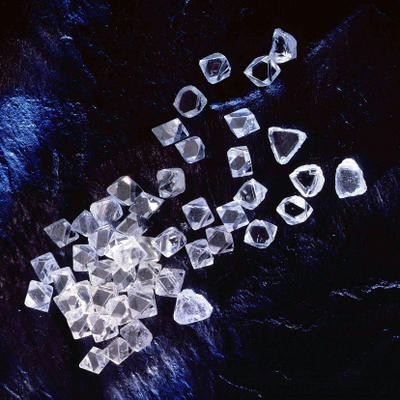 Perhaps, then, BLDGBLOG needs to update its proposal for a snowflake incubation city, and reimagine it as a city that constantly snows diamonds, thousands upon thousands of diamonds, snowing down from the roofs of cathedrals, filling inland canals, blowing through elevator shafts, falling quietly behind glass walls with a light rhythmic tap and rush. 
Artificial diamonds and the snowflake chamber, pt. 1
"It's summer in southern California, and among the palms and lemon trees a man is making snow," New Scientist writes. "Inside the physics department at Caltech in Pasadena, Kenneth Libbrecht grows tiny, frozen crystals."
 Using these manmade snowflakes, Libbrecht hopes to discover "why no two snowflakes are ever the same shape, and why they form myriad patterns of plates and needles and ferns and elaborate baroque stars."  Wounded hexagons.  This is "the art of growing ice by electricity," and it "started in 1997 as an aesthetic quest." 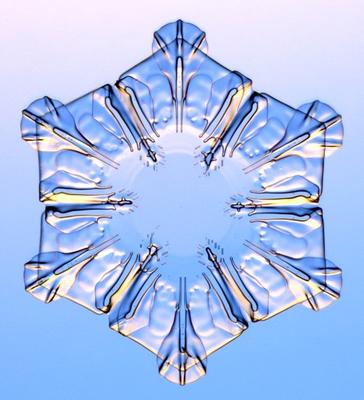 Libbrecht, in fact, has built "a snowflake incubation chamber – a steel cylinder about half a metre across with a few tubes attached. Look through a window in the side, and you can see an embryonic snowflake growing on the end of an ice needle."  This "incubation chamber" is really a kind of snowflake printer: "Libbrecht can make any of the fantastic natural shapes that fall... If he wants a plain, flat plate or a many-fingered dendrite, he just presses a few buttons, waits a few minutes, and [whoop!] there it is."  (All quotations from "Designer Snowflakes" in the 23 December 2000 issue of New Scientist. For another article, click here; and for a lecture by Libbrecht in Culver City, CA, home of the Center for Land Use Interpretation, click here. For loads of beautiful snowflake images go here. Finally, for some quite remarkable stereoscopic images of black-and-white, electro-alien high-tech snowflakes click here [the fifth from the top is insane].) Kenneth Libbrecht, it seems, has some very interesting interests (including helioseismology). In any case, Ukichiro Nakaya, at Hokkaido University, was also in on the snowflake incubation act – he's even got a "museum of snow" named after him, apparently designed by Arata Isozaki. (Ken Libbrecht himself took a "snow crystal tour" in 2002, including a stop at the Nakaya museum.)  [Nakaya's chart of snow crystallography.] Snowflakes have temperature thresholds, Nakaya realized, highs and lows a baby flake cannot cross: "If the flake teeters back and forth between these two temperatures, it will grow fast then slow, as the arm-growing mechanism turns on and off. The resulting complicated, unpredictable series of branchings eventually becomes a beautiful, classical snowflake."  In this context, another New Scientist article – "Which kind of snow?" from 23 December 2000 – follows Bill Wergin, at the U.S. Agricultural Research Service, who photographs and catalogs individual snowflakes after "coating them with a thin layer of platinum." "The result is fantastically detailed images of snowflakes in their pristine state" – albeit snowflakes in a metallized state, but no matter. (See here for some of his freaky images – and, yes, that is snow.) Metallized symmetry; elaborate baroque stars; snowflake incubation chambers... I'm tempted here to propose a new BLDGBLOG project: the snow incubation city. It would be styled after baroque Rome 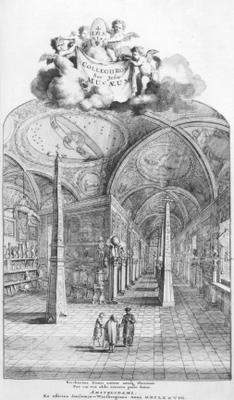 – and built entirely of snowflake incubation chambers. Within the marble domes and vaulted corridors, buttressed galleries lined with alcoves, inside the hollow columns of spiral stairs and tunneled foundations beneath gardens and their decaying granite statuary, ringed around the city like the flower warehouses of outer Holland, snow would always fall, in steady curtains or random flakes, filling up the insides of buildings; and you could wake up in the middle of the night and go walking past the windows of locked skyscrapers and abandoned churches, inside of which snow is falling, and you could explore the vast ballrooms and corporate lobbies of a moonlit world, catching wounded hexagons and frozen plates and needles of snow on your shoulders and on the backs of your hands. (And if you don't already know it, check out The Snow Show, where Zaha Hadid, Lebbeus Woods, Tadao Ando, even Anish Kapoor, built a city out of ice in Norway – and it's happening again this year.) I'm reminded of two things: 1) the movie *Real Genius* (a film bearing the rather embarrassing tagline: "When he gets mad, he doesn't get even... he gets creative"), because they build a tobogganing run out of artificial ice in the hallways of a Caltech dorm – though I'd hope that BLDGBLOG's snow city could be at least a little more interesting. And, 2) I went to a concert once in the Zionskirche, in Zionskirchplatz on the border between Mitte and Prenzlauer Berg in Berlin – this was back in the summer of 2000 – and it was nearly midnight, and a choir was there, but the church hadn't been maintained so the ceiling, throughout the concert – which was candlelit, and sounded like Arvo Pärt – the ceiling was snowing small white flakes of plaster on the choir as they sang. The inside of the church was snowing on us. The exact mathematical dimensions of angels. Well – part 2 coming up soon.  [Image: An early snow photograph, by Wilson Bentley.] Sze Tsung Leong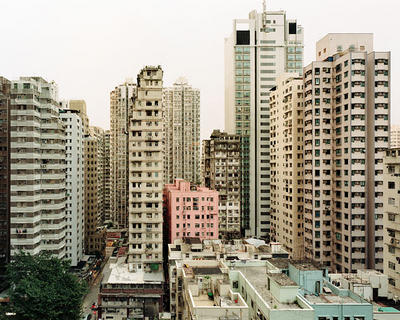 [Image: Pokfulam, Hong Kong, 2003.] 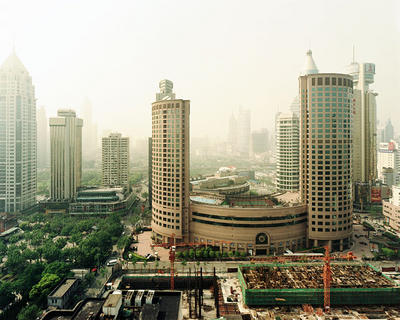 [Image: People’s Square, Luwan District, Shanghai, 2004.] 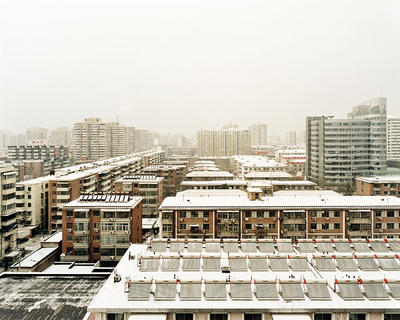 [Image: Zuojiazhuang, Chaoyang District, Beijing, 2004.] All photos by Sze Tsung Leong, whose work I find just really unbelievably great. Space in China [Image: Causeway Bay I, Hong Kong, 2004, by Sze Tsung Leong.] It was quietly announced, at the end of August, that Arup, the almost comically omnipresent British engineering firm, has won a multi-billion pound contract for the design, engineering, and construction of an entire city, to be built from scratch outside Shanghai in the Dongtan wetlands of eastern China. 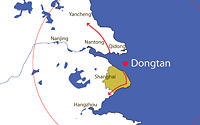 [Image from Arup's website.] The city – called, simply, Dongtan – will be "the world’s first genuinely eco-friendly city," the Times reports, "powered by renewable energy sources and as close to carbon-neutral as possible." It "will eventually extend to cover some 8,800 hectares, roughly equivalent to New York’s Manhattan island" – though Arup, it seems, will only be planning an initial "630 hectares, roughly three times the size of the City of London." Only. Arup's own press release spells out their role in great detail: "Arup is responsible for the integrated master-planning of the built environment... providing a full range of services, including urban design, planning, sustainable energy management, waste management, renewable energy process implementation, economic and business planning, sustainable building design, architecture, infrastructure and even the planning of communities and social structures." (Which, latterly, sounds rather ominous.) "Priority projects [will] include the process of capturing and purifying water in the landscape to support life in the city. Community waste management recycling will generate clean energy from organic waste, reducing landfills that damage the environment. Combined heat and power systems will provide the technology to source clean and reliable energy." Compare that to the hum-drum initiatives under discussion now to rebuild New Orleans, and you can't help but conclude that the United States is in such an advanced state of structural decrepitude and urban-imaginative bankruptcy that opening up a few branches of CVS or a Ross Dress For Less somehow passes for successful urbanism. Dongtan, Arup claims, "underline[s] the Chinese government’s move to take account of environmental considerations in future policy initiatives." Whether or not such optimism is warranted, it is interesting to read such a statement in light of an article that appeared last night in The Guardian. Its author, Jonathan Watts, suggests that "a much bleaker future" is in store for China's nascent, super-powered, high-construction economy: "Environmentally and spiritually," Watts writes, "[China's rapid development] is a disaster. China's rivers are drying up, its cities are choked with pollution, the rural health-care system has collapsed and the cities are seeing record levels of suicide and stress. China is showing all the symptoms of modernity – only on a bigger scale and at a faster rate than the world has ever seen." One could argue, however, that this increasingly catastrophic situation is exactly why the Chinese government now seeks to build a city like Dongtan. In any case, Watts ends with a kind of prescription: "In the 19th century, Britain and Europe taught the world how to produce. In the 20th, the US taught us how to consume. If China is to lead the world in the 21st century, it must teach us how to sustain." I would here hesitantly suggest that Arup's involvement with Dongtan perhaps offers an odd, if very real – if not, in fact, utopian – source of inspiration for urbanists, environmentalists, and BLDGBLOG contributors the world over. I just really, deeply, and profoundly hope, with unabashed, wide-eyed American sincerity, that Dongtan has at least one Ross Dress For Less. Returning to Watts – well, returning to the subject matter that Watts is actually discussing: the new Chinese railway to Tibet (in the context of other Chinese infrastructural projects now under construction) – we find some truly astonishing descriptions. For instance (taken, really, from a pay-per-view New York Times article): "For long stretches the [Tibet-bound] railway, which is fast nearing completion, will operate at altitudes higher than many small planes can fly, huffing and puffing far above the fragrant mists that roll down the Himalayan slopes. Indeed, the train, whose engines will need turbochargers just to get enough oxygen to run, will often soar above the clouds." (See also Archinect). Or this, from Watts: "Luxury trains are being built for the new track. They feature pressurised carriages to minimise the risk of altitude sickness [!] and tinted windows to protect from strong ultra-violet rays. (...) The cars will be pulled by diesel engines capable of maintaining an average speed of 100 kph, even at above 4,000m, when the thinness of the air can cut power by almost half." Then there's the awe-inspiring geotechnical challenge, which begs the question of whether human beings are even meant to be there in the first place (I would think not): the railway will cross "a vast sea of permafrost that stretches more than 600km across the [Qinghai] plateau towards Tibet and the Himalayas, prompting some to describe this area as the third pole of the world." This "third pole" is also known as the earthquake-prone Kunlun Pass, where "[e]ven the best Swiss tunnelling engineers concluded that it was impossible to bore through the rock and ice." Watts continues: "There were 5,000m-high mountains to climb, 12km-wide valleys to bridge, hundreds of kilometres of ice and slush that could never support tracks and trains. How could anyone tunnel through rock at -30C, or lay rails when the least exertion sends you reaching for the oxygen bottle? But that's the sort of challenge today's China relishes." China, indeed, is a nation of infrastructure. 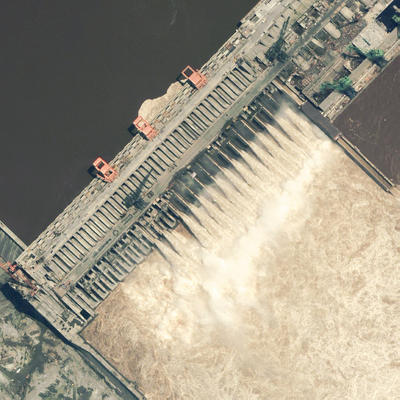 [Image: Three Gorges Dam, the largest hydroelectric dam on the planet and "China's biggest construction project since the Great Wall," Watts writes.] See, for instance, China's new highway system.  [Image: Shanghai gyratory (slideshow).] From the BBC: "Every year China is constructing around 4,000 km of expressways, towards its target of connecting every city with a population of 200,000 or more to an 85,000 km national motorway network. Half the work is already done." Will the Chinese produce their own Kerouac in 30 years? Riding the endless Chinese highways in a beat-up FAW, quoting St. Augustine and rewriting the Diamond Sutra? Or will cars become obsolete just as China's national highway system is completed? Come what may, a (now pay-per-view) article in the Engineering News-Record describes how, across bridges and inland piers, through tunnels and switchbacks, sinkholes and mines, across karst bedrock and the terrain of old wars, the Chinese highway system, come hell or high water – come permafrost or earthquakes – is being constructed. So what's the point? 1) Several generations' worth of infrastructural planning and construction are occurring in China over the span of two decades. 2) The "eco-city" of Dongtan represents a positive model for urban design and development – shaming the United States, in particular, as libertarian pro-Bush anti-urbanists face having to rebuild New Orleans, in a flood zone, below sea level. 3) The Chinese highway and train systems, impressive enough (even if only on the level of national mythology), could have disastrous religious, cultural, and environmental impacts on the people of Tibet, the population of greater China – and perhaps on the global climate at large. This is something I've hardly even begun to discuss. And yet it feels like the only real thing we can do for now is continue to watch space in China. 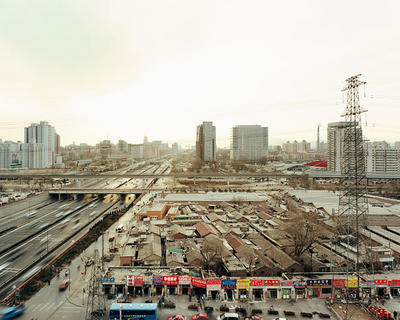 [Image: Beisihuanxi Lu, Zhongguancun, Haidian District, Beijing, 2004, by Sze Tsung Leong.] The decay rides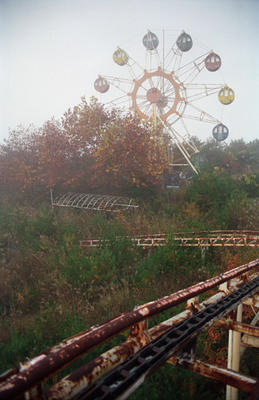 These photos of an abandoned amusement park in Japan remind me simultaneously of the recent film *Requiem for a Dream* and of an old black & white horror "classic" called *Carnival of Souls* – 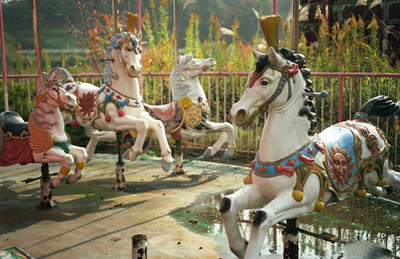 – which has an unintentionally hilarious scene in which the spooked-out heroine refuses to leave her car during an undercarriage check-up... 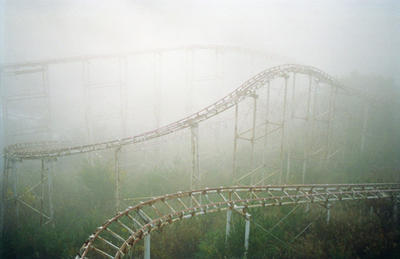 In any case, the photographer's research continues elsewhere, and with consistently high quality; and, in this context, I might humbly suggest checking out an old BLDGBLOG entry on Gunkanjima Island (which the above photographer also explores). (That is to say, he/she explores Gunkanjima Island [also called Hashima – 'Gunkanjima' means battleship, and is just a nickname], not BLDGBLOG's old entry about it...). 
Evidence of architectural thievery From, and by, gravestmor. You can hardly tell from the size of the image here, but it's very well-done... From, and by, gravestmor. You can hardly tell from the size of the image here, but it's very well-done...
Sound dunes
"Sand dunes in certain parts of the world are notorious for the noises they make," the New Scientist reports, "as sand avalanches down their sides. Some [dunes] emit low powerful booms, others sound like drum rolls or galloping horses, and some are even tuneful. These dune songs have been reported to last for up to 15 minutes and can sound as loud as a low-flying aeroplane."
To test for the causes, properties, and other effects of these sand dune booms, "Stéphane Douady of the French national research agency CNRS and his colleagues shipped sand from Moroccan singing dunes back to his lab to investigate."  A miniature landscape, cut from the whole, DHL'd back to the home lab for testing. There, Douady's team "found that they could play notes by pushing the sand by hand, or with a metal handle." The transformation of a sand dune – and, by extension, the entire Sahara desert, indeed any desert – even, by extension, the rust deserts of Mars – into a musical instrument. Music of the spheres, indeed. "When the sand avalanches, the grains jostle each other at different frequencies, setting up standing waves in the cascading layer, says Douady. These waves reinforce one another, making the layer vibrate like the surface of a loud speaker. 'What's funny is that in these massive dunes, only a thin layer of 2 or 3 centimetres is needed to set up the resonance,' says Douady. 'Soon all grains begin to vibrate in step.'" Douady has so perfected his technique of dune resonance that he has now "successfully predicted the notes emitted by dunes in Morocco, Chile and the US simply by measuring the size of the grains they contain." The music of the dunes, in other words, was determined entirely by the size, shape, and roughness of the sand grains involved, where excessive smoothness dampened the dunes' sound.  I'm reminded of the coast of Inishowen, a peninsula south of Malin Head in the north of Ireland, where the rocks endlessly grind across one another in the backwash of heaving, metallic, grey Atlantic waves. Under constant pressure of the oceanic, the rocks carve into themselves and each other, chipping down over decades into perfectly polished and rounded spheres, columns, and eggs – as if Archimedean solids or the nested orbits of Kepler could be discovered on the Irish ocean foreshore –  – all glittering. The rocks, I later learned, were actually semi-precious stones, and I had a kind of weird epiphany, standing there above the hush and clatter of bejewelled rocks, rubbing and rubbed one to the other in the depopulated void of a coastal November. It was not a sound easy to forget. Because the earth itself is already a musical instrument: there is "a deep, low-frequency rumble that is present in the ground even when there are no earthquakes happening. Dubbed the 'Earth's hum', the signal had gone unnoticed in previous studies because it looked like noise in the data." Elsewhere: "Competing with the natural emissions from stars and other celestial objects, our Earth sings like a canary – it drones on in a constant hum of a gazillion notes. If it were several octaves higher, and hence, audible to the human ear," it could probably get recorded by the unpredictably omnidirectional antennas of ShortWaveMusic and... you could download the sound of the earth. Free Radio Interterrestrial. [Note: the "drones on" link, a sentence or two back, offers a contrary theory (published in 2000) about the origins of these planetary soundwaves.] Which, finally, brings us to Ernst Chladni and his Chladni figures, or: architectonic structures appearing in sand due to patterns of acoustic resonance. Architecture through sound, involving sand. Silicon assuming structure. Desert harddrive, humming. The gist of Chladni's experiments involved spreading a thin layer of sand across a vibrating plate, changing the frequency at which the plate vibrated, and then watching the sand as it shivered round, forming regular, highly geometric patterns. Those patterns depended upon, and were formed in response to, whatever vibration frequency it was that Chladni chose. 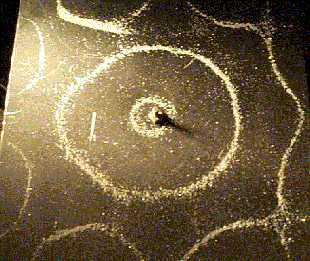  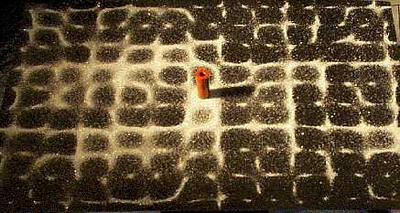 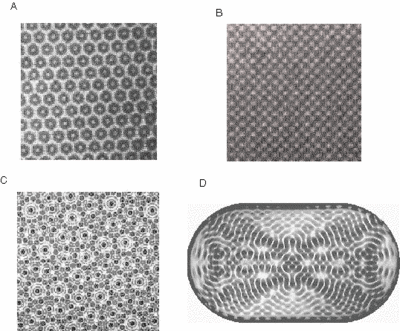 So you've got sand, dune music, terrestrial vibration, some Chladni figures – one could be excused for wondering whether the earth, apparently a kind of carbon-ironic bell made of continental plates and oceanic resonators, is really a vast Chladni plate, vibrating every little mineral, every pebble, every grain of sand, perhaps every organic molecule, into complex, three-dimensional, time-persistent patterns for which we have no standard or even technique of measurement. Or maybe William Blake knew how to do it, or Pythagoras, or perhaps even Nicola Tesla, but... The sound dunes continue to boom and shiver. The deserts roar. The continents hum.
|